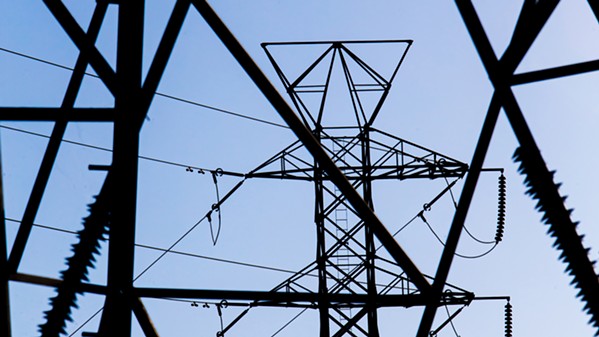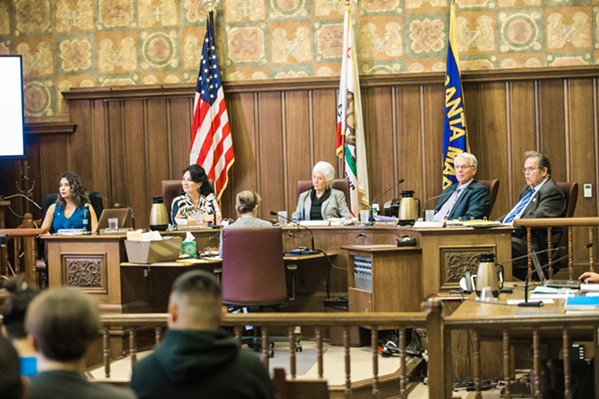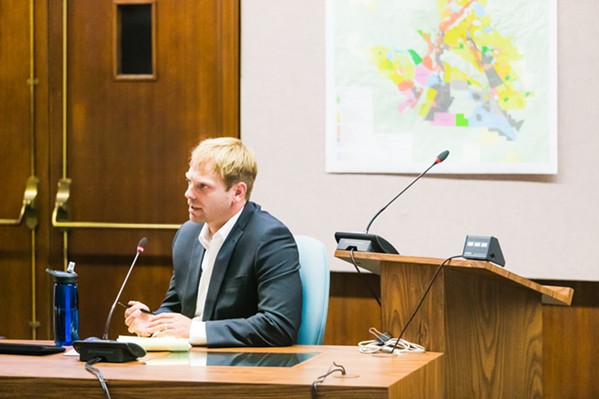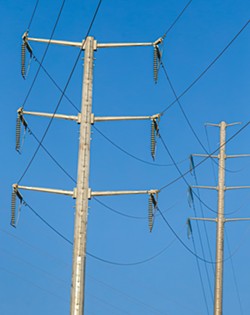[{
"name": "Ad - Medium Rectangle CC01 - 300x250",
"id": "AdMediumRectangleCC01300x250",
"class": "inlineCenter",
"insertPoint": "8",
"component": "2963441",
"requiredCountToDisplay": "12"
},{
"name": "Ad - Medium Rectangle LC01 - 300x250",
"id": "AdMediumRectangleCC01300x250",
"class": "inlineCenter",
"insertPoint": "18",
"component": "2963441",
"requiredCountToDisplay": "22"
},{
"name": "Ad - Medium Rectangle LC09 - 300x250",
"id": "AdMediumRectangleLC09300x250",
"class": "inlineCenter",
"insertPoint": "28",
"component": "3252660",
"requiredCountToDisplay": "32"
}]
The expansion happened fast.
In the span of a year, 10 Central Coast cities and Santa Barbara County all had voted, one after the other, to join as members of Monterey Bay Community Power (MBCP), a growing Community Choice Energy (CCE) utility that currently serves Monterey, Santa Cruz, and San Benito counties.
It started with San Luis Obispo and Morro Bay in late 2018. Then Paso Robles and Grover Beach in spring 2019. By the end of August, Santa Maria, Pismo Beach, Arroyo Grande, Guadalupe, Goleta, Carpentaria, and unincorporated Santa Barbara County had all jumped on board with MBCP—capping a near region-wide transition to the electricity provider.
"It just kind of took off," said J.R. Killigrew, director of communications for MBCP. "In six months, we more or less have unified the Central Coast."
Each city came at MBCP from a different angle—but all that voted to join noted the CCE's lower rates and carbon-free energy portfolio compared to PG&E.
"I think it's a safe bet," said Mike Cordero, a Santa Maria City Council member. "The cost of power goes down, and we won't be using any fossil fuel energy."
MBCP is a CCE agency (also known as Community Choice Aggregation or CCA), which is a joint powers authority of local governments that buys power for its collective ratepayers and sells it over existing transmission lines as a cleaner, cheaper alternative to the incumbent utility. With the southbound expansion, MBCP's total customers are expected to almost double, from 275,000 to 470,000 accounts, along with its revenue, making it one of the largest CCE entities in the state.
"If we can expand and scale this kind of model that we've seen tremendous success with within Monterey, San Benito, and Santa Cruz counties," Killigrew said, "it really just fits perfectly with our goals and mission as an agency."
CCE took a long time to take hold in California. But the concept is now proliferating across the state. When MBCP first launched in 2018, it was one of 10 others like it created in the state that year, boosting the overall CCE count to 19. CCEs now procure power for about 4 million customers, or close to a quarter of California's electricity load.
"You can see the explosion start to happen," said Beth Vaughan, executive director of CalCCA, a legislative advocacy organization for CCE. "It absolutely makes sense that the local communities want their energy providers to be local."
As SLO and Morro Bay gear up to start MBCP service in January 2020—the remaining jurisdictions begin theirs in 2021—proponents say this power pivot aligns the Central Coast with the state's aggressive push to lower its carbon emissions, while critics question whether CCEs can deliver on their promises of lower rates, cleaner energy, and local control.
Origins
Before Santa Cruz County Supervisor Bruce McPherson was a pioneer in the CCE world (and a decline-to-state politician), his past life was as a Republican state Assembly member, senator, and secretary of state from 2005 to 2007.
All of those years spent in Sacramento exposed McPherson to the concept of CCE, he said. When he retired from state politics and decided to run for local office in 2012, McPherson made CCE a priority in Santa Cruz County.
"After I ran for county supervisor, one of the first things I did was say, 'This would be a great thing to do.' And we started down the road," McPherson said.
It took several years for the project to gain traction, but eventually the vision for a tri-county CCE venture, MBCP, came to fruition. For McPherson, who now chairs MBCP's policy board, CCE is about local control, doing right by the environment, and saving ratepayers money.
"It's a win-win-win situation," he said. "I agree it seems, in some respects, like it's too good to be true."
That's what several elected officials in SLO and Santa Barbara counties said as MBCP made its pitch. What's the catch?
MBCP claims there isn't one.
Now entering its third year as an agency, MBCP has paid off all of its startup debt and managed to amass close to $100 million in reserves. Along with its carbon-free energy mix, MBCP offered 3 percent rate rebates in its first year, 5 percent rebates in its second year, and plans to provide a discount of 7 percent on monthly bills in 2020. It invests more than $1 million per year into local green energy initiatives, like incentive programs for electric vehicle sales and residential solar projects.
"We give back to the community if there's any profits," McPherson said.
MBCP proponents say those benefits and investment opportunities are only going to expand as the agency picks up customers across the region. Elected officials and community leaders can shape those programs while serving on MBCP's policy, operations, and community advisory boards. If a city has more than 50,000 people, it gets its own board member. If it has fewer than 50,000, it shares a seat with a nearby small community. SLO Mayor Heidi Harmon is representing both SLO and Morro Bay on MBCP's policy board in 2020.
"A mission-driven public organization is able to invest more directly into the community," explained Chris Read, SLO city's sustainability manager. "It's this cycle of economic development and improving local quality of life."
McPherson, who's a Cal Poly alumnus, said MBCP's rapid spread through SLO and Santa Barbara counties has even surprised him.
"Frankly, we've grown more quickly than I might've imagined," he said.
Splitting it up
When a CCE like MBCP enters a community, it doesn't kick PG&E out of town. PG&E is still delivering the power, maintaining the lines, and billing for it like usual. In fact, a customer isn't likely going to notice the switch to MBCP unless he or she is paying close attention to their bill, Killigrew said.
"It's a virtual switch," he said. "The lights don't change any different color. The electrons don't flow differently all of the sudden. Everything stays the same."
What's changed is the entity that's making decisions about what power to buy on your behalf. Instead of PG&E making those calls and getting paid for it, MBCP is.
"[Ratepayers] are now financially supporting MBCP and our power procurement strategies," Killigrew said.
Between November and February, SLO and Morro Bay residents will receive four alerts in the mail about their January 2020 transition to MBCP. The mailers will explain what's coming and how to revert back to PG&E if preferred.
All of the roughly 30,000 customers in SLO and Morro Bay will be automatically enrolled in MBCP unless they individually opt out. Customers have 60 days after enrollment to do so free of charge. Otherwise, they'll have to pay an administrative fee of $5 for a residential account and $25 for a commercial account. Once a ratepayer opts out, he or she has to stay with PG&E for a full year before switching back.
For those who stay with MBCP (96 percent of current ratepayers have chosen to stay), their utility bill essentially gets broken into two separate line charges—a line charge to PG&E for distribution, and another line charge to MBCP for power generation. MBCP uses that revenue to secure energy contracts, provide its rate discounts, and run the local energy programs.
Right now, the majority of MBCP's power is sourced from large hydroelectric plants in the Pacific Northwest—which are carbon free but, like nuclear power plants, do not qualify as renewable in California because of their environmental impacts. Qualified renewables include solar, wind, small hydro, geothermal, and biomass.
In the "who's cleaner" competition, MBCP's basic mix beats PG&E's on carbon: MBCP has a 100 percent carbon-free portfolio, while PG&E's is 80 percent carbon-free. But on the renewable front, PG&E actually edges MBCP with a higher share of renewables—39 percent to 34 percent. MBCP does offer a "prime" package of 100 percent renewables for 1 cent per kilowatt more.
Renewables are a work in progress for MBCP, Killigrew said. Last year, MBCP signed two long-term contracts to develop solar-plus-battery storage in Kings and Kern counties. The projects are being touted as the "largest utility-scale, solar-plus-storage project ever built in California." When completed, they are expected to provide 278 megawatts of solar capacity combined, plus 85 megawatts of storage.
MBCP is also pursuing wind farms. It recently entered into a contract to receive power from a New Mexico wind farm that's under construction, and it has an memorandum of understanding with Castle Wind, a German outfit, to do business if it wins a bid to open a wind farm off the shores of Morro Bay.
That's not all, Killigrew said.
"We've shortlisted another six to seven potential renewable energy projects that we hope to have contracts finalized by the end of the year," he said. "We're looking at basically having projects to meet somewhere around 40 percent of our annual electric load of the new service area, including Santa Barbara and SLO County."
Suzanne Hosn, a PG&E spokesperson, said in statement to New Times: "We respect the energy choices that are available to our customers, and will continue to cooperate with local governments as they consider pursuing and/or developing a CCA program."
State law bars the company from speaking freely about CCE in public.
"PG&E delivers some of the nation's cleanest electric power," Hosn added. "For more than 100 years, it has been PG&E's privilege to provide our customers clean, reliable, and affordable energy, and we look forward to the opportunity to do so for many years to come."
Lingering concerns
Despite the overall strong support for MBCP on the Central Coast, some jurisdictions were not interested in joining the CCE wave. SLO County and Atascadero both declined to participate in 2021.
"We're taking a big step that I don't believe there's any going back from," said SLO County 5th District Supervisor Debbie Arnold. "I don't think we got anywhere near enough debate with the public."
County and Atascadero elected officials are skeptical about MBCP's promised benefits—that electricity rates would actually remain low, that the energy programs would come back to help their communities, that they'd really achieve local control.
The issue of local control is of concern to both proponents and opponents of MBCP. As the number of its participating jurisdictions surpasses 20, retaining the "community" in community power will be a challenge going forward.
"We do need to be paying close attention that our expansion is something that can be properly managed," SLO Mayor Harmon said. "That's definitely top of mind for the board. People need to be represented and make sure we don't get too big."
MBCP says it has no plans to grow the organization beyond the five-county region. But for Santa Maria Mayor Alice Patino, that's already too big.
"You really don't have local control anymore," said Patino, who was in the Santa Maria City Council minority opposed to MBCP. "Whatever decision the majority makes in [MBCP], we'll have to go along with. There may come a time when we want to opt out because we don't agree with a decision, and can we do that at that time is really a big question."
In response to its own concerns about MBCP, the SLO County Board of Supervisors decided to hire a consultant to produce a $25,000 independent fiscal analysis of MBCP—which will be presented to the board on Oct. 1. At that date, though, it will be too late for the county to change its mind and enroll in the 2021 cycle.
"We're doing our due diligence. For me this is all about saving people money," said SLO County 1st District Supervisor John Peschong. "We need to do this study to get the real answers here."
The debate over MBCP in SLO County and Atascadero has evolved into something of a political battle, with the board's and council's conservative members butting heads against their liberal members. SLO County 4th District Supervisor Lynn Compton once called the push for CCE just another "bomb" thrown by progressives into the local political scene. Mike Brown, the governmental affairs director for COLAB in SLO County, who attends nearly every SLO County Board of Supervisors meeting, ripped MBCP as a "scam" on Sept. 10.
"If you end up buying into this, you're going to follow the rest of the sheep into this huge costly scam, which will destroy our integrated energy system and end up costing people lots of money and lots of problems," Brown said.
He tempered his words in a phone call with New Times, when he said: "We're government watchdogs. We don't think creating a plethora of new governments is a great idea."
McPherson, the Santa Cruz County supervisor who helped found MBCP, believes that the CCE discussion "has no room for partisanship."
"I know the split down there in SLO," he said. "I think it's short-sighted. It's probably the national political scene. I'm not going to get into the aspects of how much climate change is going to melt the waters in how many years, I'm just saying it's better to have a clean environment for our production of electricity, no matter what, and it's especially beneficial if it costs less."
California's push
CCE law has been around since 2002 in California, but the first program, Marin Community Power, didn't form until 2010. Over the next five years, a few more were established in the Bay Area. Over the last five years, CCE has taken off across the state. The trend is expected to continue: By 2025, PG&E estimates that CCE programs will have absorbed 85 percent of its load share.
Vaughan, of the CCE advocacy group, CalCCA, said several factors have contributed to this movement. The threat of climate change has propelled cities and counties to look at ways they can lower their community carbon footprint. And the state Legislature has adopted aggressive renewable energy mandates that align with CCE's mission. Senate Bill 100, passed in 2018, set 2045 as the target date to achieve 100 percent carbon-free electricity.
"What we see with our energy sector, the transition we're going through, is how we're going to achieve SB 100," Vaughan said. "We have a climate crisis, so what happens next? How do we collectively as a group make sure we respond to these challenges and ensure we achieve our climate goal?"
Read, SLO city's sustainability manager, said the growth of CCE is helping push incumbent utilities like PG&E to meet their renewable targets faster.
"A lot of the utilities were hitting their renewable portfolio standards targets, but the CCAs come online and the rate that that acceleration is occurring is dramatic," Read said. "They're pushing forward at a more rapid pace."
But there are also some people who are concerned about so much shuffling around in the market. PG&E's bankruptcy and Diablo Canyon Power Plant's looming closure only compound those qualms.
Last year, the California Public Utilities Commission, which regulates the power industry, commissioned a report about how CCE is altering the energy landscape. The report raised questions: "How do we protect safe delivery of electricity to meet customer demand in an increasingly fragmented market? How will we ensure that increasing fragmentation of suppliers and buyers will add up to meet our ambitious clean energy goals?"
For some, the situation echoes the conditions that precipitated the electricity crisis of the early 2000s.
"We can talk about the failed energy deregulation 20 years ago. We remember how quickly that fell apart," Peschong, SLO County's 1st District Supervisor, said.
As CCE becomes an increasingly bigger player in the state energy mix, some predict that investor-owned utilities' business model will have to shift away from load serving toward distribution and wholesale production. How it all shakes out is an unfolding story.
"All of that is up in the air," Vaughan said.
As for MBCP—which will eventually be renamed and rebranded with a Central Coast regional theme—its rapid expansion through the Central Coast is an indicator of just how much CCE has caught on in California.
SLO Mayor Harmon, whose city is chasing a 2035 net-zero emissions goal, believes the jurisdictions that held out of MBCP—and CCE in general—will come to reconsider.
"The county and city will really soon come to see the economic, not to mention the environmental, benefits of it," Harmon said. "I think eventually you'll see the entire state and entire country in CCE programs. That's only a matter of time." ∆
Assistant Editor Peter Johnson can be reached at [email protected].
Speaking of Monterey Bay Community Power, MBCP
-
A response to a response
Dec 19, 2019 -
California's green energy future
Nov 7, 2019 -
Dear neighbors
Nov 7, 2019 - More »
Latest in News
Comments (3)
Showing 1-3 of 3
Readers also liked…
-

Coast Unified teachers upset over new position's salary and qualifications
Oct 20, 2022 -

SLO police identify alleged driver who hit and killed couple
Dec 22, 2022 -

When the levee breaks: Oceano residents, county officials walk a tightrope of regulations to manage Arroyo Grande Creek, which some say led to the levee's failure in January
May 18, 2023














